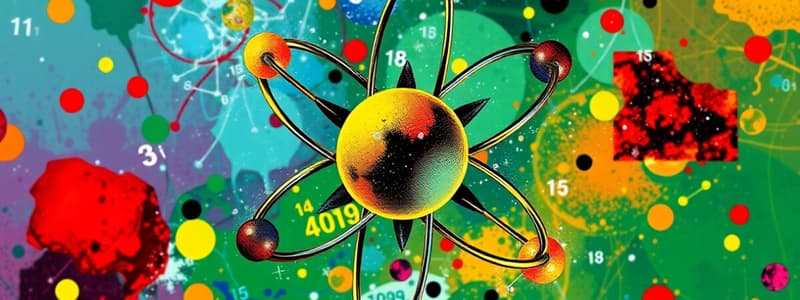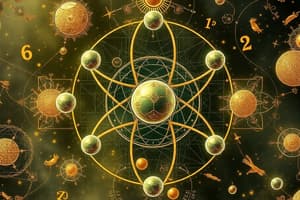Podcast
Questions and Answers
What type of particle is found in the nucleus of an atom and has a positive charge?
What type of particle is found in the nucleus of an atom and has a positive charge?
- Nucleus
- Electron
- Proton (correct)
- Neutron
Electrons occupy regions of space known as atomic orbitals.
Electrons occupy regions of space known as atomic orbitals.
True (A)
What is the mass of a proton in grams?
What is the mass of a proton in grams?
1.672 x 10^-24
The __________ principle states that no two electrons in an atom can have the same set of quantum numbers.
The __________ principle states that no two electrons in an atom can have the same set of quantum numbers.
Match the quantum numbers with their descriptions:
Match the quantum numbers with their descriptions:
What is the maximum number of electrons that can occupy a single orbital?
What is the maximum number of electrons that can occupy a single orbital?
Neutrons carry a positive charge.
Neutrons carry a positive charge.
What is the lowest energy orbital that can be occupied by an electron?
What is the lowest energy orbital that can be occupied by an electron?
Hund’s rule states that electrons must enter degenerate orbitals __________ and will remain unpaired as long as possible.
Hund’s rule states that electrons must enter degenerate orbitals __________ and will remain unpaired as long as possible.
Which quantum number indicates the region of greatest probability of finding an electron?
Which quantum number indicates the region of greatest probability of finding an electron?
What type of hybridization is found in the covalent compounds of Group II elements?
What type of hybridization is found in the covalent compounds of Group II elements?
The bond angle in the water molecule (H2O) is exactly 180°.
The bond angle in the water molecule (H2O) is exactly 180°.
Which type of bonding involves the sharing of electron pairs between atoms?
Which type of bonding involves the sharing of electron pairs between atoms?
The geometry of molecules with sp3 hybridization is typically __________.
The geometry of molecules with sp3 hybridization is typically __________.
Match the type of bond to its description.
Match the type of bond to its description.
Which hybridization involves one s and two p orbitals?
Which hybridization involves one s and two p orbitals?
Ionic bonding involves the sharing of electrons between atoms.
Ionic bonding involves the sharing of electrons between atoms.
What electron orbitals contribute to the hybrid orbitals in sp hybridization?
What electron orbitals contribute to the hybrid orbitals in sp hybridization?
In covalent bonding, the more electronegative atom tends to attract the bonding electron density, causing __________.
In covalent bonding, the more electronegative atom tends to attract the bonding electron density, causing __________.
Which of the following is a characteristic of sp orbitals?
Which of the following is a characteristic of sp orbitals?
What term describes the process of losing one or more electrons?
What term describes the process of losing one or more electrons?
Transition elements always lose electrons from their outermost s orbitals first during ionization.
Transition elements always lose electrons from their outermost s orbitals first during ionization.
What is the primary reason that certain electronic configurations are more stable?
What is the primary reason that certain electronic configurations are more stable?
In periodic tables, the rows are called ______ and the columns are known as ______.
In periodic tables, the rows are called ______ and the columns are known as ______.
Match the following elements with their atomic numbers:
Match the following elements with their atomic numbers:
What configuration does chromium exhibit?
What configuration does chromium exhibit?
Electronegativity increases from left to right across a period.
Electronegativity increases from left to right across a period.
What type of bond is formed through the transfer of electrons?
What type of bond is formed through the transfer of electrons?
Anions form when elements from Groups ______ and ______ accept electrons.
Anions form when elements from Groups ______ and ______ accept electrons.
Which of the following describes the process of orbital hybridization?
Which of the following describes the process of orbital hybridization?
What type of bond is formed by overlapping sp orbitals on carbon and p orbitals on oxygen in carbon dioxide?
What type of bond is formed by overlapping sp orbitals on carbon and p orbitals on oxygen in carbon dioxide?
Hydrogen bonding is a strong interaction primarily responsible for the high boiling point of water.
Hydrogen bonding is a strong interaction primarily responsible for the high boiling point of water.
What is the term for the covalent bond where both electrons come from a single atom?
What is the term for the covalent bond where both electrons come from a single atom?
In hydrogen cyanide (HCN), carbon forms a _____ bond with nitrogen.
In hydrogen cyanide (HCN), carbon forms a _____ bond with nitrogen.
Which of the following is an example of an oxyacid?
Which of the following is an example of an oxyacid?
Match the type of bond to its description:
Match the type of bond to its description:
Which of the following molecules exhibits resonance?
Which of the following molecules exhibits resonance?
Van der Waals forces are the strongest bonds present in molecular interactions.
Van der Waals forces are the strongest bonds present in molecular interactions.
What type of molecular interaction plays a significant role in the secondary structure of proteins?
What type of molecular interaction plays a significant role in the secondary structure of proteins?
The degree of _____ indicates that electrons are delocalized in certain molecules.
The degree of _____ indicates that electrons are delocalized in certain molecules.
Flashcards are hidden until you start studying
Study Notes
Electronic Structure of Atoms
-
Atoms are composed of a central nucleus surrounded by electrons.
-
The nucleus consists of protons (positive charge) and neutrons (no charge).
-
Protons and neutrons comprise most of the atom's mass.
-
The number of protons, also known as the atomic number, determines the element.
-
The atomic mass is the sum of protons and neutrons.
-
Electrons occupy specific regions of space around the nucleus called atomic orbitals.
-
Atomic orbitals are described by four quantum numbers:
- Principal quantum number (n): Defines the energy level of an electron. Higher n values indicate higher energy levels and greater distance from the nucleus.
- Azimuthal quantum number (l): Describes the shape of the orbital and ranges from 0 to n-1.
- l=0 corresponds to an s orbital (spherical)
- l=1 corresponds to a p orbital (dumbbell shaped)
- l=2 corresponds to a d orbital (more complex shapes)
- l=3 corresponds to an f orbital (even more complex shapes)
- Magnetic quantum number (ml): Specifies the orientation of the orbital in space.
- Spin quantum number (ms): Represents the intrinsic angular momentum of an electron, which is quantized and has a value of +1/2 or -1/2.
-
To determine electron configuration, several principles are used:
- Aufbau principle: Electrons are added to orbitals in order of increasing energy.
- Pauli exclusion principle: No two electrons in an atom can have the same set of quantum numbers. This limits each orbital to a maximum of two electrons with opposite spins.
- Hund's rules:
- Electrons fill lower energy orbitals before higher energy orbitals.
- Within a subshell, electrons occupy orbitals singly before pairing up. Singly occupied orbitals have parallel spins.
- In transition series, d orbitals are often half-filled or fully filled, leading to more stable configurations.
-
Ionization: The process of losing one or more electrons, creating a positively charged ion (cation).
-
The ease of ionization depends on how loosely bound the valence electrons are.
-
Ionization can result in changes in the electronic structure of the ion compared to the original atom.
Periodic Table
- Organized by increasing atomic number, electron configurations, and recurring chemical properties.
- Rows are called periods, columns are called groups.
- Groups broadly indicate shared chemical properties related to their valence electron configurations.
- Groups IA and IIA are called "typical elements" as they primarily fill s and p orbitals.
- Transition elements fill d orbitals.
- Lanthanides and actinides fill f orbitals.
- Electronegativity: An element's affinity to gain electrons. Increases from left to right and bottom to top in the periodic table.
- Electropositivity: An element's tendency to lose electrons. Increases down a group.
Electronic Structure of Molecules
-
Three major forces driving molecule formation:
- Coulombic attraction between the negatively charged electron cloud of one atom and the positively charged nucleus of another.
- Valence electron distribution.
- Orbital interactions.
-
Types of chemical bonds:
- Covalent bonds: Involve electron sharing between atoms.
- Nonpolar: Equal sharing, found in homonuclear diatomic molecules (e.g., H2, Cl2).
- Polar: Unequal sharing, found in heteronuclear diatomic molecules (e.g., HCl).
- Ionic bonds: Involve electrostatic attraction due to electron transfer between atoms. Found in compounds between metals and nonmetals (e.g., NaCl).
- Orbital hybridization: "Mixing" atomic orbitals to form new orbitals with different spatial orientations and directional properties. Hybridization is key to understanding the geometry and bonding in many molecules.
- sp hybridization: Results in two linear orbitals, common in Group II elements (e.g., BeCl2).
- sp2 hybridization: Results in three planar orbitals at 120° angles, common in Group III elements (e.g., boron compounds).
- sp3 hybridization: Results in four tetrahedral orbitals at 109.5° angles, common in Group IV elements (e.g., methane, CH4).
- Covalent bonds: Involve electron sharing between atoms.
Types of Bonding Interactions
-
Ionic bonding: Attractive force between oppositely charged ions.
- Metals tend to lose electrons to form cations.
- Nonmetals tend to gain electrons to form anions.
- The octet rule (8 valence electrons) often drives ionic bond formation.
-
Covalent bonding: Attractive force between atoms sharing electrons.
- Sigma (σ) bonds: Symmetrical electron distribution along the bond axis, typically formed by overlap of s orbitals and/or hybrid orbitals.
- Pi (π) bonds: Electron density above and below the bond axis, formed by lateral overlap of p orbitals. Multiple covalent bonds (double, triple) involve sigma and pi bonding interactions.
-
Coordinate covalent bonding: One atom provides both electrons for the shared bond. Often found in complex molecules and involves a donor-acceptor interaction.
-
Hydrogen bonding: A strong dipole-dipole interaction between an electronegative atom (typically O, N, F) and a hydrogen atom bonded to another electronegative atom. Often responsible for high boiling points in water and other properties.
-
Van der Waals (London) forces: Weaker interactions arising from temporary fluctuations in electron distribution, leading to short-lived dipoles. Responsible for attractions between noble gas atoms and contribute to intermolecular forces.
Resonance
- Delocalization of electrons over multiple atoms in a molecule. Resonance structures capture possible electron arrangements.
- Resonance is especially important in describing the electronic structure of molecules with multiple bonds and extended systems like benzene.
Studying That Suits You
Use AI to generate personalized quizzes and flashcards to suit your learning preferences.




